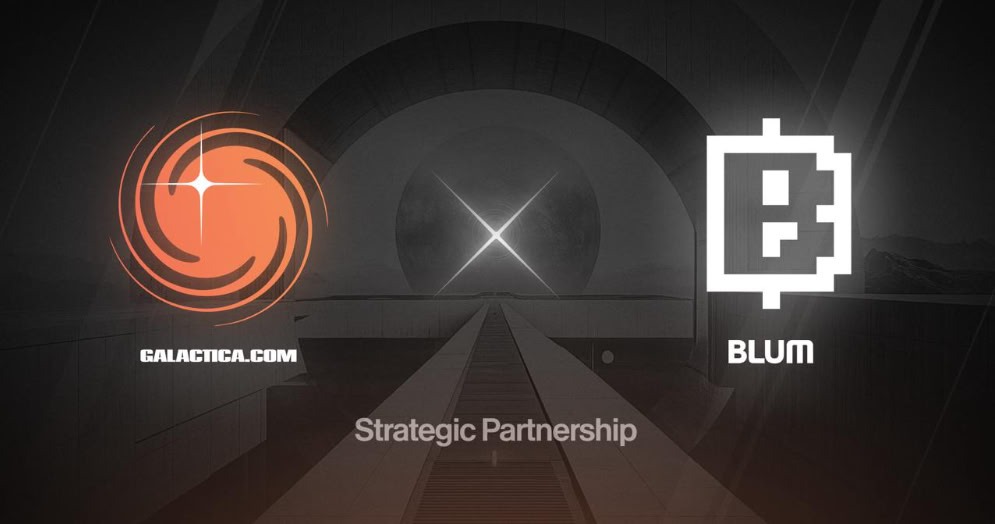

Galactica.com and Blum Labs: Pioneering Telegram-native Private Identities
With Blum Labs stepping up to join Galactica's board, a new chapter unfolds in the development of a full-blown private Telegram passport and adoption for Galactica.com Identity Virtual Machine (IVM) within the vast realm of the Telegram ecosystem.

Galactica.com stands at the forefront of privacy blockchain innovation, particularly in the realms of applied FHE and Web3 Identity.Today we are excited to unveil a strategic partnership with Blum.io- the largest and most vibrant Telegram community. There is no utility more powerful than a functional IVM as it is central to having a sovereign internet. The aim of the partnership is to distribute the nodes that are key to Galactica.com decentralization over Blum's 70m+ user community and advance further IVM penetration into the Telegram ecosystem and beyond.With Blum Labs stepping up to join Galactica's board, a new chapter unfolds in the development of a full-blown private Telegram passport and adoption for Galactica.com Identity Virtual Machine (IVM) within the vast realm of the Telegram ecosystem.
Background
Telegram has close to 1B active users, making it the biggest distribution venue for web3 products. Galactica.com, an IVM (identity Virtual Machine) protocol, has just announced a collaboration with Blum to deploy the Galactica Telegram Passport to this vast user base.The Galactica Telegram Passport is a digital identity solution, powered by Fully Homomorphic Encryption (FHE) and Zero Knowledge Proofs (ZK), that is integrated with a native Telegram interface, allowing every Telegram user to securely store and manage their personal data right within their messaging app.Galactica is pushing the boundaries of decentralized identity by embedding itself deeply within the Telegram ecosystem. Galactica developed the Identity Virtual Machine (IVM), the ultimate identity stack to create and manage Digital Identities & Web3 reputation.
IVM Utility - too powerful for a centralized control
The TL;DR of the IVM concept should probably go along the following lines: Galactica.com introduces the concept of the Identity Virtual Machine (IVM), which is designed to position actionable identity as a core primitive powering dApps across the Web3 ecosystem. While the Ethereum Virtual Machine (EVM) computes over public address balances, the IVM can compute over normalized, encrypted private data. IVM is a requirement to make your data an asset for AI applications and beyond (More can be found here).Apart from its many use-cases, such as sovereign AI agents, RWAs and undercollateralized lending, IVM enables something much more important. It is the backbone of sovereign blockchain-native social and political institutions. It is central to the concept of sovereign internet.This is exactly why, Galactica.com's mission is maximum decentralization.Since its inception,Galactica.com has been community-funded and owned. This approach ensures that a utility as vital as an IVM remains free from corporate profit-centric influence over its community, autonomy and roadmap. Almost 80% of the $GNET supply is reserved to be community governed or owned.The node distribution process we are launching with Blum.io is central to this effort.
Launch of Galactica Nodes Sale on Blum.io
Recognizing the technological excellence and market fit of Galactica's technological stack, Blum.io is launching the sale of Galactica.com nodes. These nodes are pivotal to IVM decentralization and are offering holders the opportunity to earn attractive APY. As we have highlighted elsewhere in the node distribution documentation, the most important part of this APY is its meritocratic nature. Those users who contribute more to the evolution of the ecosystem will stand to earn the most. In this way as time goes, the total circulating $GNET supply will end up accumulating to those most worthy. It is the perfect mechanism to dynamically align the ecosystem interests and its community.Let's delve deeper into the notion of Galactica.com nodes and distributional meritocracy.
Node Distribution: The Meritocracy at its finest
Let us begin with some background:
In any blockchain ecosystem, clear goals are established to ensure the network's growth, security, and sustainability. These goals often include decentralization, scalability, and secure transaction processing.
The community plays a crucial role in achieving these objectives, particularly through actions like running nodes, participating in governance, and promoting the ecosystem.
To motivate community members to contribute, the ecosystem offers incentives such as block rewards for validators, position in the governance, or staking rewards.
Generalizing this point, incentives can be for anything that can be reliably measured and does benefit the network - validation, building, marketing, community work, liquidity provision, etc, etc.
These incentives align the interests of participants with the long-term success of the ecosystem.
This last point is also what is known as incentive alignment - similar to what concerns many contemporary thinkers in the context of AI (more here). Let's explore the alignment problem in the context of blockchain communities:
Defining good incentives is the single most important challenge when designing decentralized ecosystems. Although it's hard to define a universal set of incentives, there are certain fundamental properties good incentives have.
The incentives in a blockchain ecosystem should ideally bediverse, coming from multiple sources to reward a wide range of contributions. This could include rewards for validating blocks, participating in governance, driving community initiatives, and developing new features or services.
Additionally, incentives must be dynamic, adjusting over time as the ecosystem evolves, ensuring that contributions remain aligned with the network's current needs.
Lastly, these rewards should be meritocratic, where contributions are fairly compensated based on the value and effort provided. Those who actively contribute benefit, while those who cease to participate naturally are no longer eligible for rewards.
This structure encourages continuous engagement and fosters long-term growth. Node Sales has been created to achieve this goal. For more information see here)
Now it's time to talk about node sales. For the purpose of this article, node sale and node distribution can be used interchangeably, but in a broader Galactica.com context, not all nodes are sold - there are other ways to get one - hence, we prefer the latter term.
The concept of anode sale is straightforward: users purchase a node in the network, granting them the right to perform specific tasks for the ecosystem in reward for inflation rewards.
These tasks can range from technical operations like running a validator node to liquidity contributions or even community-building efforts like creating content.
Each type of effort has a dedicated allocation of tokens, which are gradually released as rewards, with higher payouts going to those who demonstrate better performance.
While the idea isn't new-it's the core mechanism behind validator nodes in Proof of Stake (PoS) networks, where rewards are tied to node performance metrics like uptime and block validation-the node sale model extends this principle.
It generalizes the idea to include any kind of measurable contribution to the network, allowing for a broader range of tasks to earn rewards in a systematic way.
In this way as time goes by more tokens that are released into circulation end up in the pockets of those who deserve it the most, effectively diluting less contributing holders in favor of those who contribute the most.
In this way, if designed right, node economy is meritocracy at its finest.
Now when everyone has a firm grasp on the notion of node sales, let's talk about Galactica Node Distribution process:
The Galactica Node Distribution (GND) allows participants to contribute to the network and earn rewards by actively engaging with its growth.
Through participating in the GND process, users can purchase a Galactica Citizen Node (GCN) or a Galactica Node Shard (GNS), granting them the right to perform some tasks for the network. Participants can execute tasks, such as running validators, entering the governance, contributing to the community, and more in order to earn rewards.
Of the total GNET supply, 30.68% is allocated to GND, divided into three reward categories: Node Drop (13.6%), Merit-Based Airdrop aka UBI (6%), and Validation Rewards (11.08%).
The NodeDrop program allocates GNET based on tiered contributions, with 5% unlocking at the Token Generation Event (TGE), followed by a 3-month cliff and 24 months of linear vesting.
The Merit-Based Airdrop aka UBI is similar to a continuous airdrop that rewards active node holders, providing ongoing incentives for participation.
Additionally, GCN and GNS holders can stake their GNET to earn Validation Rewards, further boosting their rewards.
Over time, the Galactica ecosystem is designed to naturally dilute the rewards of participants who do not actively contribute, and transfer these rewards to active node holders.
This meritocratic model ensures that only those who continue to engage with the network-whether through technical tasks, community-building, or other efforts-will see their rewards grow.
Participants who fail to contribute will see their share diminish as more rewards are directed to active contributors, aligning the long-term success of the network with the efforts of its most committed participants. This dynamic system encourages ongoing participation and fosters sustained ecosystem growth.
Conclusion
This partnership marks a significant step toward a more private, user-centric Web3 ecosystem. By combining Blum's extensive reach with Galactica.com's robust IVM technology, the world will reinvent the concept of internet sovereignty, redefining on and off chain interactions within the Telegram platform and far beyond. Galactica's Node Sale on Blum platform is a huge testament to the potential of decentralization. Remember, IVM is too big to be owned by any single interest.We are excited to take this journey forward together. Its endgame is definitely worth it.







